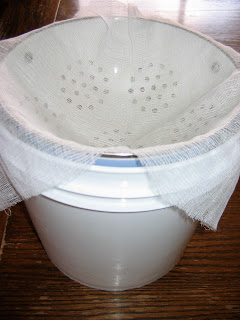Rendering lard may sound a bit scary, but it is actually quite a simple process. The steps consist of:
- Melt
- Strain
- Store
Step 1: Melt
I started off with 3 frozen 4-5lb packages of ground Crooked Gap Farm lard. Start the heat low (mine was 1-2 on our electric stove) until you get a nice puddle of melted lard. Once you get a nice puddle, you can turn the heat up a bit (I went from 3-5). Stir occasionally, taking care to scrape the bottom. If your lard starts bubbling, you might want to turn it down. This will keep the meat bits from scorching on the bottom. I also like to use a heavy pan, in these pictures - my pressure canner pan, to keep the lard from scorching. The bits of meat in the lard will start to float. Once they sink again, your lard is ready to strain!
8:55 am :: Starting to melt frozen lard.
9:50 am :: Lard is melting nicely. I can turn up the heat a little since there is a good amount of melted lard.
11:14 am :: Lard "bricks" are gone. Bits of meat are floating. (You can actually start straining lard at this point if you like - the first few batches will be your whitest lard.)
3:05 pm :: Came in from chores to find bits of meat had sunk to the bottom. Done!
Step 2: Strain
I recently discovered how helpful it is to use two strainers when straining the lard. The bottom strainer has a layer of cheesecloth (found in the Walmart Craft department for making ghosts and things). The cheesecloth will strain out the tiniest bits of meat and allow the liquid to drip through. The top strainer catches the larger bits of meat and keeps the cheesecloth less clogged up. The bits of meat caught in the top strainer can be returned to the pan to melt down further and further until you get cracklings, if you like them. (Hopefully I'll get pictures of the crackling process sometime.) You can either strain your lard into the container you want to store it in, another pan to keep it warm before filling smaller containers, or straight into smaller containers - which I'm not so talented in doing.
Strainer 1 set up with cheesecloth over container.
Strainer 2 set inside strainer 1 to catch meat and help keep cheesecloth clean.
Step 3: Store
After you have strained your lard and filled your sterilized containers, you need to set it aside and allow it to cool. This can take a day or more to completely finish depending on the temperature and size of container. You can either let your lard cool at room temperature or put it right into the freezer to get a more even consistency. Lard will keep best if the final product is stored in the freezer, but it can also be kept in the fridge, root cellar, or on the counter if kept sealed.
After your lard has been strained into a container of your choice. I used this large bucket since I have a project up my sleeves! While your lard is still warm, it will have a deep amber color. Just set it aside now to cool.
Once your lard has fully cooled, it will be a beautiful white color.
One of my favorite ways to store lard is in quart jars - ready to pull out and use for my cooking. The lids will self seal as the lard cools.
Using your Lard
You may notice that your lard is quite soft and might almost be runny at room temperature - this is a good thing! It shows the high quality of your lard - unlike the lard that has been hydrogenated at the grocery store. In order to make your lard easier to work with, you may want to put it in the fridge or freezer a bit before using it, especially if cutting it into pastries.
More Info
For more info on the home rendered lard and its health benefits, see the following sites:
- The Unbearable Lightness of Lard: http://hardscrabbletimes.c
om/2008/08/29/the-unbearab le-lightness-of-lard/ - Praise the Lard: http://www.pri.org/health/
praise-the-lard1453.html - What's "The good lard" http://www.pri.org/stories
/health/praise-the-lard145 3.html
Follow The Beginning Farmer's Wife on Facebook for additional personal peeks at building a family farm.










3 comments:
I remember my grandmother rendering lard in the 1950s and my mother used lard too but we had moved to town when I can first remember so Mom had to buy lard or get it from Gramma. At rendering time, the grown ups enjoyed the cracklins and I tried to like them!
Don't you just LOVE the look of all those beautiful jars of freshly rendered lard? The white-ness of it just blew me away!
Also, I've chosen your blog for a Liebster Award. You can read the details on our blog http://beyondthebluegate.blogspot.com
I'm a little late in commenting on this blog but what a nice job you did! Love all the pics. I too render lard from our pigs and how wonderful is that?! My pie crusts this year were fantastic...but my fillings still need work :)
Post a Comment